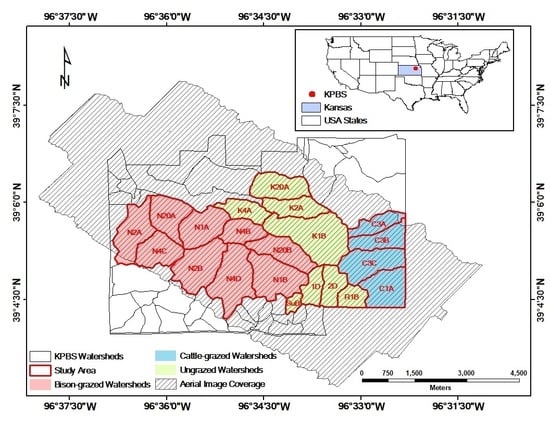Effects of Fire and Large Herbivores on Canopy Nitrogen in a Tallgrass Prairie
Abstract
:1. Introduction
2. Methods
2.1. Study Area
2.2. Data Collection and Preprocessing
2.3. Data Analysis
2.3.1. Watershed-Level Descriptive Statistics and Spatial Heterogeneity Metrics
2.3.2. Variograms for Different Fire and Grazing Treatments
3. Results
3.1. Fire Effects on Canopy Nitrogen in Ungrazed Watersheds
3.2. Interactive Effects of Fire and Large Herbivores
3.3. Spatial Structure of Canopy Nitrogen Distrubtion
4. Discussion
4.1. Fire, Ungulate Grazing, and Vegetation Canopy
4.2. Use of Remote Sensing Imagery
5. Conclusions
Author Contributions
Funding
Acknowledgments
Conflicts of Interest
References
- Collins, S.L.; Wallace, L.L. Fire in North American Tallgrass Prairies; University of Oklahoma Press: Norman, OK, USA, 1990. [Google Scholar]
- Bowles, M.L.; Jones, M.D. Repeated burning of eastern tallgrass prairie increases richness and diversity, stabilizing late successional vegetation. Ecol. Appl. 2013, 23, 464–478. [Google Scholar] [CrossRef] [PubMed]
- Evans, E.W.; Briggs, J.M.; Finck, E.J.; Gibson, D.J.; James, S.W.; Kaufman, D.W.; Seastedt, T.R. Is fire a disturbance in grasslands? In Proceedings of the Eleventh North American Prairie Conference, Lincoln, NE, USA, 7–11 August 1988; pp. 159–161. [Google Scholar]
- Neary, D.G.; Klopatek, C.C.; DeBano, L.F.; Ffolliott, P.F. Fire effects on belowground sustainability: A review and synthesis. For. Ecol. Manag. 1999, 122, 51–71. [Google Scholar] [CrossRef]
- Abrams, M.D.; Knapp, A.K.; Hulbert, L.C. A ten-year record of aboveground biomass in a Kansas USA tallgrass prairie: Effects of fire and topographic position. Am. J. Bot. 1986, 73, 1509–1515. [Google Scholar] [CrossRef]
- Anderson, T.M.; Ritchie, M.E.; Mayemba, E.; Eby, S.; Grace, J.B.; McNaughton, S.J. Forage nutritive quality in the serengeti ecosystem: The roles of fire and herbivory. Am. Nat. 2007, 170, 343–357. [Google Scholar] [CrossRef] [PubMed]
- Seastedt, T.R.; Knapp, A.K. Consequences of nonequilibrium resource availability across multiple time scales: The transient maxima hypothesis. Am. Nat. 1993, 141, 621–633. [Google Scholar] [CrossRef]
- Hobbs, N.T.; Schimel, D.S.; Owensby, C.E.; Ojima, D.S. Fire and grazing in the tallgrass prairie: Contingent effects on nitrogen budgets. Ecology 1991, 72, 1374–1382. [Google Scholar] [CrossRef]
- Seastedt, T.R.; Ramundo, R.A. The influence of fire on belowground processes of tallgrass prairie. In Fire in North American Tallgrass Prairies; Collins, S.L., Wallace, L.L., Eds.; University of Oklahoma Press: Norman, OK, USA, 1990; pp. 99–117. [Google Scholar]
- Blair, J.M. Fire, N availability, and plant response in grasslands: A test of the transient maxima hypothesis. Ecology 1997, 78, 2359–2368. [Google Scholar] [CrossRef]
- Anderson, R.C. The historic role of fire in the North American grassland. In Fire in North American Tallgrass Prairies; Collins, S.L., Wallace, L.L., Eds.; University of Oklahoma Press: Norman, OK, USA, 1990; pp. 8–18. [Google Scholar]
- Bragg, T.B.; Hulbert, L.C. Woody plant invasion of unburned Kansas bluestem prairie. J. Range Manag. 1976, 29, 19–24. [Google Scholar] [CrossRef]
- Collins, S.L.; Gibson, D.J. Effects of fire on community structure in tallgrass and mixed-grass prairie. In Fire in North American Tallgrass Prairies; Collins, S.L., Wallace, L.L., Eds.; University of Oklahoma Press: Norman, OK, USA, 1990; pp. 81–98. [Google Scholar]
- Svejcar, T.J. Response of Andropogon gerardii to fire in the tallgrass prairie. In Fire in North American Tallgrass Prairies; Collins, S.L., Wallace, L.L., Eds.; University of Oklahoma Press: Norman, OK, USA, 1990; pp. 19–27. [Google Scholar]
- Loucks, O.L. Evolution of diversity, efficiency, and community stability. Am. Zool. 1970, 10, 17–25. [Google Scholar] [CrossRef]
- Anderson, K.L.; Smith, E.F.; Owensby, C. Burning bluestem range. J. Range Manag. 1970, 23, 81–92. [Google Scholar] [CrossRef]
- Archibald, S.; Bond, W.J.; Stock, W.D.; Fairbanks, D.H.K. Shaping the landscape: Fire-grazer interactions in an African savanna. Ecol. Appl. 2005, 15, 96–109. [Google Scholar] [CrossRef]
- Fuhlendorf, S.D.; Engle, D.M. Restoring heterogeneity on rangelands: Ecosystem management based on evolutionary grazing patterns. Bioscience 2001, 51, 625–632. [Google Scholar] [CrossRef]
- Hickman, K.R.; Hartnett, D.; Cochran, R.C.; Owensby, C. Grazing management effects on plant species diversity in tallgrass prairie. J. Range Manag. 2004, 57, 58–65. [Google Scholar] [CrossRef]
- Belsky, A.J. Does herbivory benefit plants? A review of the evidence. Am. Nat. 1986, 127, 870–892. [Google Scholar] [CrossRef]
- De Mazancourt, C.; Loreau, M.; Abbadie, L. Grazing optimization and nutrient cycling: When do herbivores enhance plant production? Ecology 1998, 79, 2242–2252. [Google Scholar] [CrossRef]
- McNaughton, S.J. Compensatory plant growth as a response to herbivory. Oikos 1983, 40, 329–336. [Google Scholar] [CrossRef]
- Collins, S.L.; Knapp, A.K.; Briggs, J.M.; Blair, J.M.; Steinauer, E.M. Modulation of diversity by grazing and mowing in native tallgrass prairie. Science 1998, 280, 745–747. [Google Scholar] [CrossRef]
- Frank, D.A.; Evans, R.D. Effects of native grazers on grassland N cycling in Yellowstone National Park. Ecology 1997, 78, 2238–2248. [Google Scholar] [CrossRef]
- McNaughton, S.J.; Banyikwa, F.F.; McNaughton, M.M. Promotion of the cycling of diet-enhancing nutrients by African grazers. Science 1997, 278, 1798–1800. [Google Scholar] [CrossRef]
- Wang, X.; Mcconkey, B.G.; Vandenbygaart, A.J.; Fan, J.; Iwaasa, A.; Schellenberg, M. Grazing improves C and N cycling in the Northern Great Plains: A meta-analysis. Sci. Rep. 2016, 6, 33190. [Google Scholar] [CrossRef]
- Derner, J.D.; Briske, D.D.; Boutton, T.W. Does grazing mediate soil carbon and nitrogen accumulation beneath C4, perennial grasses along an environmental gradient? Plant Soil 1997, 191, 147–156. [Google Scholar] [CrossRef]
- Frank, D.A.; Groffman, P.M.; Evans, R.D.; Tracy, B.F. Ungulate stimulation of nitrogen cycling and retention in Yellowstone Park grasslands. Oecologia 2000, 123, 116–121. [Google Scholar] [CrossRef] [PubMed]
- Allred, B.W.; Fuhlendorf, S.D.; Engle, D.M.; Elmore, R.D. Ungulate preference for burned patches reveals strength of fire-grazing interaction. Ecol. Evol. 2011, 1, 132–144. [Google Scholar] [CrossRef] [PubMed]
- Coppedge, B.R.; Shaw, J.H. Bison grazing patterns on seasonally burned tallgrass prairie. J. Range Manag. 1998, 51, 258–264. [Google Scholar] [CrossRef]
- Anderson, R.C. Evolution and origin of the Central Grassland of North America: Climate, fire, and mammalian grazers. J. Torrey Bot. Soc. 2006, 133, 626–647. [Google Scholar] [CrossRef]
- Raynor, E.J.; Joern, A.; Nippert, J.B.; Briggs, J.M. Foraging decisions underlying restricted space use: Effects of fire and forage maturation on large herbivore nutrient uptake. Ecol. Evol. 2016, 6, 5843–5853. [Google Scholar] [CrossRef] [PubMed]
- Strand, E.K.; Launchbaugh, K.L. Livestock grazing effects on fuel loads for wildland fire in sagebrush dominated ecosystems. J. Rangel. Appl. 2014, 1, 35–57. [Google Scholar]
- Starns, H.D.; Fuhlendorf, S.D.; Elmore, R.D.; Twidwell, D.; Thacker, E.T.; Hovick, T.J.; Luttbeg, B. Recoupling fire and grazing reduces wildland fuel loads on rangelands. Ecosphere 2019, 10, e02578. [Google Scholar] [CrossRef]
- Fuhlendorf, S.D.; Engle, D.M. Application of the fire-grazing interaction to restore a shifting mosaic on tallgrass prairie. J. Appl. Ecol. 2004, 41, 604–614. [Google Scholar] [CrossRef]
- Fuhlendorf, S.D.; Engle, D.M.; Kerby, J.; Hamilton, R. Pyric herbivory: Rewilding landscapes through the recoupling of fire and grazing. Conserv. Biol. 2009, 23, 588–598. [Google Scholar] [CrossRef]
- Kohl, M.T.; Krausman, P.R.; Kunkel, K.; Williams, D.M. Bison versus cattle: Are they ecologically synonymous? Rangel. Ecol. Manag. 2013, 66, 721–731. [Google Scholar] [CrossRef]
- Allred, B.W.; Fuhlendorf, S.D.; Hovick, T.J.; Elmore, R.D.; Engle, D.M.; Joern, A. Conservation implications of native and introduced ungulates in a changing climate. Glob. Chang. Biol. 2013, 19, 1875–1883. [Google Scholar] [CrossRef] [PubMed]
- Fuhlendorf, S.D.; Davis, C.A.; Elmore, R.D.; Goodman, L.E.; Hamilton, R.G. Perspectives on grassland conservation efforts: Should we rewild to the past or conserve for the future? Philos. Trans. R. Soc. Lond. B Biol. Sci. 2018, 373, 20170438. [Google Scholar] [CrossRef] [PubMed]
- Tucker, M.A.; Böhning-Gaese, K.; Fagan, W.F.; Fryxell, J.M.; Van Moorter, B.; Alberts, S.C.; Ali, A.H.; Allen, A.M.; Attias, N.; Avgar, T.; et al. Moving in the anthropocene: Global reductions in terrestrial mammalian movements. Science 2018, 359, 466–469. [Google Scholar] [CrossRef] [PubMed]
- Hartnett, D.C.; Hickman, K.R.; Walter, L.E.F. Effects of bison grazing, fire, and topography on floristic diversity in tallgrass prairie. J. Range Manag. 1996, 49, 413–420. [Google Scholar] [CrossRef]
- Fuhlendorf, S.D.; Townsend, D.E.; Elmore, R.D.; Engle, D.M. Pyric-herbivory to promote rangeland heterogeneity: Evidence from small mammal communities. Rangel. Ecol. Manag. 2010, 63, 670–678. [Google Scholar] [CrossRef]
- Collins, S.L.; Smith, M.D. Scale-dependent interaction of fire and grazing on community heterogeneity in tallgrass prairie. Ecology 2006, 87, 2058–2067. [Google Scholar] [CrossRef]
- Koerner, S.E.; Collins, S.L. Interactive effects of grazing, drought, and fire on grassland plant communities in North America and South Africa. Ecology 2014, 95, 98–109. [Google Scholar] [CrossRef] [Green Version]
- Augustine, D.J.; Frank, D.A. Effects of migratory grazers on spatial heterogeneity of soil nitrogen properties in a grassland ecosystem. Ecology 2001, 82, 3149–3162. [Google Scholar] [CrossRef]
- Wallace, L.L.; Turner, M.G.; Romme, W.H.; Oneill, R.V.; Wu, Y.G. Scale of heterogeneity of forage production and winter foraging by elk and bison. Landsc. Ecol. 1995, 10, 75–83. [Google Scholar] [CrossRef]
- Jago, R.A.; Cutler, M.E.J.; Curran, P.J. Estimating canopy chlorophyll concentration from field and airborne spectra. Remote Sens. Environ. 1999, 68, 217–224. [Google Scholar] [CrossRef]
- Kokaly, R.F.; Despain, D.G.; Clark, R.N.; Livo, K.E. Mapping vegetation in Yellowstone National Park using spectral feature analysis of AVIRIS data. Remote Sens. Environ. 2003, 84, 437–456. [Google Scholar] [CrossRef] [Green Version]
- Martin, M.E.; Aber, J.D. High spectral resolution remote sensing of forest canopy lignin, nitrogen, and ecosystem processes. Ecol. Appl. 1997, 7, 431–443. [Google Scholar] [CrossRef]
- Mutanga, O.; Skidmore, A.K.; Kumar, L.; Ferwerda, J. Estimating tropical pasture quality at canopy level using band depth analysis with continuum removal in the visible domain. Int. J. Remote Sens. 2005, 26, 1093–1108. [Google Scholar] [CrossRef]
- Li, H.B.; Reynolds, J.F. A simulation experiment to quantify spatial heterogeneity in categorical maps. Ecology 1994, 75, 2446–2455. [Google Scholar] [CrossRef]
- Curran, P.J. The semivariogram in remote sensing: An introduction. Remote Sens. Environ. 1988, 24, 493–507. [Google Scholar] [CrossRef]
- Koerner, S.E. Small-scale patch structure in North American and South African grasslands responds differently to fire and grazing. Landsc. Ecol. 2013, 28, 1293–1306. [Google Scholar] [CrossRef]
- Raynor, E.J.; Joern, A.; Briggs, J.M. Bison foraging responds to fire frequency in nutritionally heterogeneous grassland. Ecology 2015, 96, 1586–1597. [Google Scholar] [CrossRef] [Green Version]
- Raynor, E.J.; Beyer, H.L.; Briggs, J.M.; Joern, A. Complex variation in habitat selection strategies among individuals driven by extrinsic factors. Ecol. Evol. 2017, 7, 1802–1822. [Google Scholar] [CrossRef] [Green Version]
- Allred, B.W.; Fuhlendorf, S.D.; Hamilton, R.G. The role of herbivores in Great Plains conservation: Comparative ecology of bison and cattle. Ecosphere 2011, 2, 1–17. [Google Scholar] [CrossRef]
- Ling, B.; Goodin, D.G.; Mohler, R.L.; Laws, A.N.; Joern, A. Estimating canopy nitrogen content in a heterogeneous grassland with varying fire and grazing treatments: Konza prairie, Kansas, USA. Remote Sens. 2014, 6, 4430–4453. [Google Scholar] [CrossRef]
- Konza Prairie LTER. Available online: http://www2.konza.ksu.edu/ (accessed on 15 March 2019).
- Knapp, A.K.; Blair, J.M.; Briggs, J.M.; Collins, S.L.; Hartnett, D.C.; Johnson, L.C.; Towne, E.G. The keystone role of bison in North American tallgrass prairie. Bioscience 1999, 49, 39–50. [Google Scholar] [CrossRef]
- Briggs, J.M.; Knapp, A.K. Determinents of C3 forb growth and production in a C4 dominated grassland. Plant Ecol. 2001, 152, 93–100. [Google Scholar] [CrossRef]
- Gibson, D.J.; Hulbert, L.C. Effects of fire, topography and year-to-year climatic variation on species composition in tallgrass prairie. Vegetatio 1987, 72, 175–185. [Google Scholar] [CrossRef]
- Collins, S.L.; Calabrese, L.B. Effects of fire, grazing and topographic variation on vegetation structure in tallgrass prairie. J. Veg. Sci. 2012, 23, 563–575. [Google Scholar] [CrossRef]
- Briggs, J.M.; Blair, J.M.; Horne, E.A. Ecohydrological and climate change studies at the Konza Prairie Biological Station. Trans. Kans. Acad. Sci. 2016, 119, 5–11. [Google Scholar] [CrossRef]
- Grudzinski, B.P.; Daniels, M.D.; Anibas, K.; Spencer, D. Bison and cattle grazing management, bare ground coverage, and links to suspended sediment concentrations in grassland streams. JAWRA J. Am. Water Resour. Assoc. 2016, 52, 16–30. [Google Scholar] [CrossRef]
- Olson, K.C. PBG06 Cattle Grazing and Cattle Performance in the Patch-Burn Grazing Experiment at Konza Prairie. Available online: http://lter.konza.ksu.edu/content/pbg06-cattle-grazing-and-cattle-performance-patch-burn-grazing-experiment-konza-prairie (accessed on 15 March 2019).
- Evans, I.S. The selection of class intervals. Trans. Inst. Br. Geogr. 1977, 2, 98–124. [Google Scholar] [CrossRef]
- McGarigal, K.; Marks, B.J. FRAGSTATS: Spatial Pattern Analysis Program for Quantifying Landscape Structure; US Department of Agriculture, Forest Service, Pacific Northwest Research Station: Portland, OR, USA, 1995; Volume 351.
- Woodcock, C.E.; Strahler, A.H.; Jupp, D.L.B. The use of variograms in remote sensing: I. Scene models and simulated images. Remote Sens. Environ. 1988, 25, 323–348. [Google Scholar] [CrossRef]
- Harris, A.T.; Asner, G.P.; Miller, M.E. Changes in vegetation structure after long-term grazing in pinyon-juniper ecosystems: Integrating imaging spectroscopy and field studies. Ecosystems 2003, 6, 368–383. [Google Scholar] [CrossRef]
- Reich, P.B.; Peterson, D.W.; Wedin, D.A.; Wrage, K. Fire and vegetation effects on productivity and nitrogen cycling across a forest-grassland continuum. Ecology 2001, 82, 1703–1719. [Google Scholar]
- Ojima, D.S.; Schimel, D.S.; Parton, W.J.; Owensby, C.E. Long- and short-term effects of fire on nitrogen cycling in tallgrass prairie. Biogeochemistry 1994, 24, 67–84. [Google Scholar] [CrossRef]
- Manning, G.C.; Baer, S.G.; Blair, J.M. Effects of grazing and fire frequency on floristic quality and its relationship to indicators of soil quality in tallgrass prairie. Environ. Manag. 2017, 60, 1–14. [Google Scholar] [CrossRef] [PubMed]
- Nippert, J.B.; Ocheltree, T.W.; Skibbe, A.M.; Kangas, L.C.; Ham, J.M.; Arnold, K.B.S.; Brunsell, N.A. Linking plant growth responses across topographic gradients in tallgrass prairie. Oecologia 2011, 166, 1131–1142. [Google Scholar] [CrossRef] [PubMed]
- Nippert, J.B.; Culbertson, T.S.F.; Orozco, G.L.; Ocheltree, T.W.; Helliker, B.R. Identifying the water sources consumed by bison: Implications for large mammalian grazers worldwide. Ecosphere 2013, 4, 1–13. [Google Scholar] [CrossRef]
- Raynor, E.J.; Joern, A.; Skibbe, A.; Sowers, M.; Goodin, D. Temporal variability in large grazer space use in an experimental landscape. Ecosphere 2017, 8, e01674. [Google Scholar] [CrossRef]
- Raynor, E.J. Ecological Hierarchy of Foraging in a Large Herbivore: The Plains Bison Perspective in Tallgrass Prairie. Ph.D. Thesis, Kansas State University, Manhattan, KS, USA, 2015. [Google Scholar]
- Venter, Z.S.; Hawkins, H.; Cramer, M.D. Implications of historical interactions between herbivory and fire for rangeland management in African savannas. Ecosphere 2017, 8, e01946. [Google Scholar] [CrossRef]
- Afzal, M.; Adams, W.A. Heterogeneity of soil mineral nitrogen in pasture grazed by cattle. Soil Sci. Soc. Am. J. 1992, 56, 1160–1166. [Google Scholar] [CrossRef]
- Adler, P.B.; Raff, D.A.; Lauenroth, W.K. The effect of grazing on the spatial heterogeneity of vegetation. Oecologia 2001, 128, 465–479. [Google Scholar] [CrossRef] [PubMed]
- Cid, M.S.; Brizuela, M.A. Heterogeneity in tall fescue pastures created and sustained by cattle grazing. J. Range Manag. 1998, 51, 644–649. [Google Scholar] [CrossRef]
- Adler, P.B.; Lauenroth, W.K. Livestock exclusion increases the spatial heterogeneity of vegetation in Colorado shortgrass steppe. Appl. Veg. Sci. 2000, 3, 213–222. [Google Scholar] [CrossRef]
- Fynn, R.W.S.; O’Connor, T.G. Effect of stocking rate and rainfall on rangeland dynamics and cattle performance in a semi-arid savanna, South Africa. J. Appl. Ecol. 2000, 37, 491–507. [Google Scholar] [CrossRef]
- Porensky, L.M.; Derner, J.D.; Augustine, D.J.; Milchunas, D.G. Plant community composition after 75 yr of sustained grazing intensity treatments in shortgrass steppe. Rangel. Ecol. Manag. 2017, 70, 456–464. [Google Scholar] [CrossRef]
- Adler, P.B.; Hall, S.A. The development of forage production and utilization gradients around livestock watering points. Landsc. Ecol. 2005, 20, 319–333. [Google Scholar] [CrossRef]
- Abrams, M.D.; Hulbert, L.C. Effect of topographic position and fire on species composition in tallgrass prairie in northeast Kansas USA. Am. Midl. Nat. 1987, 117, 442–445. [Google Scholar] [CrossRef]
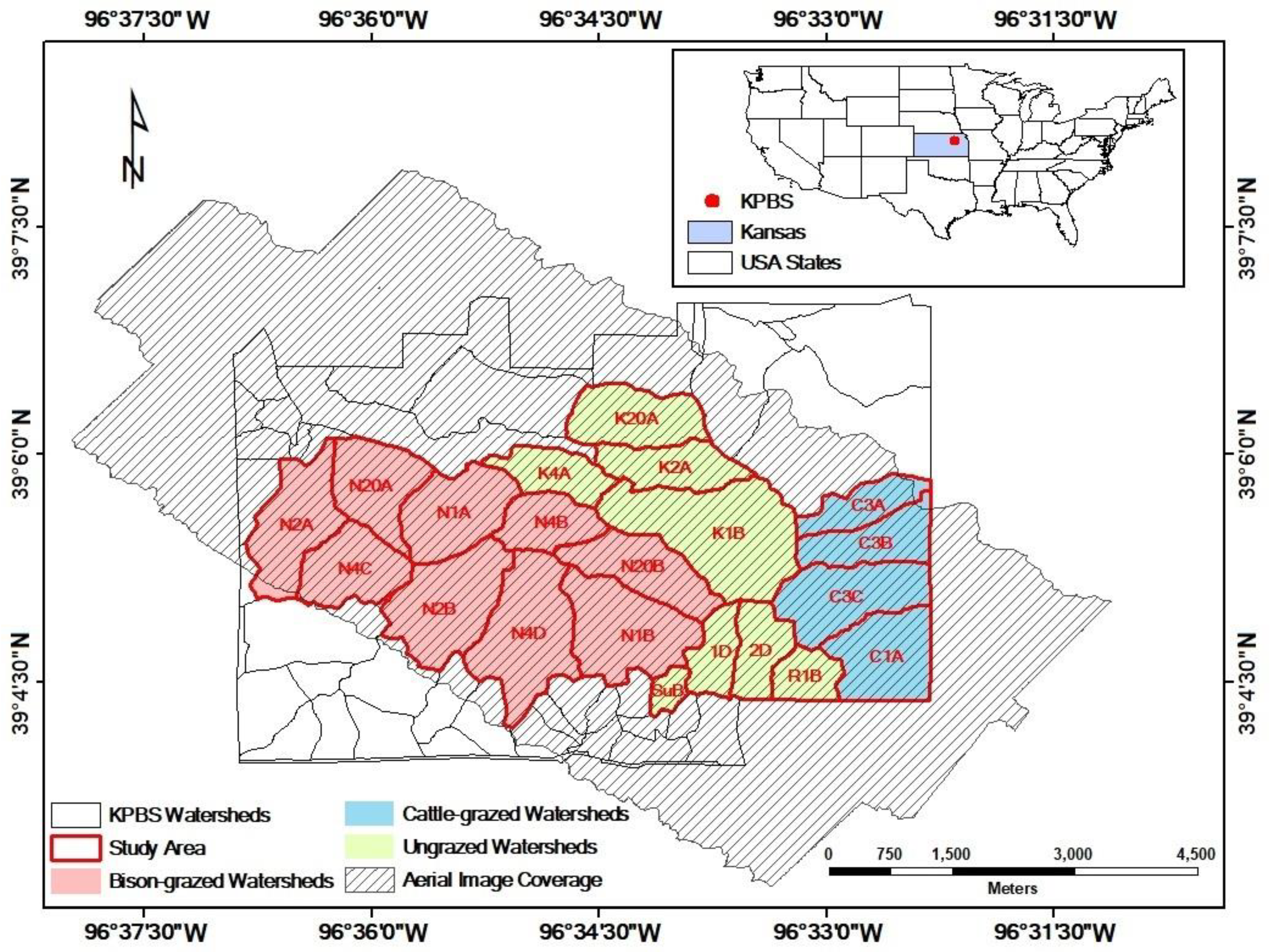
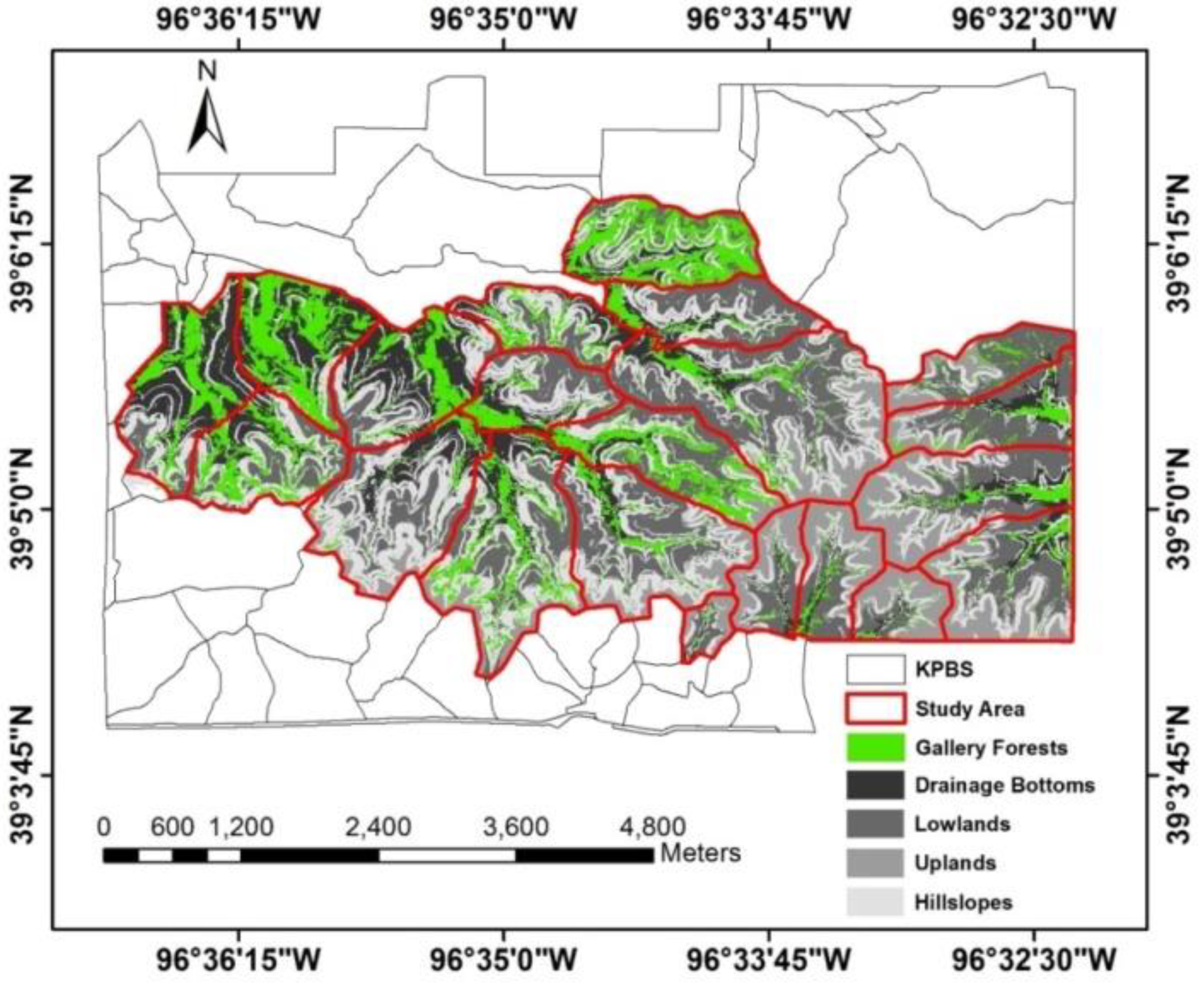

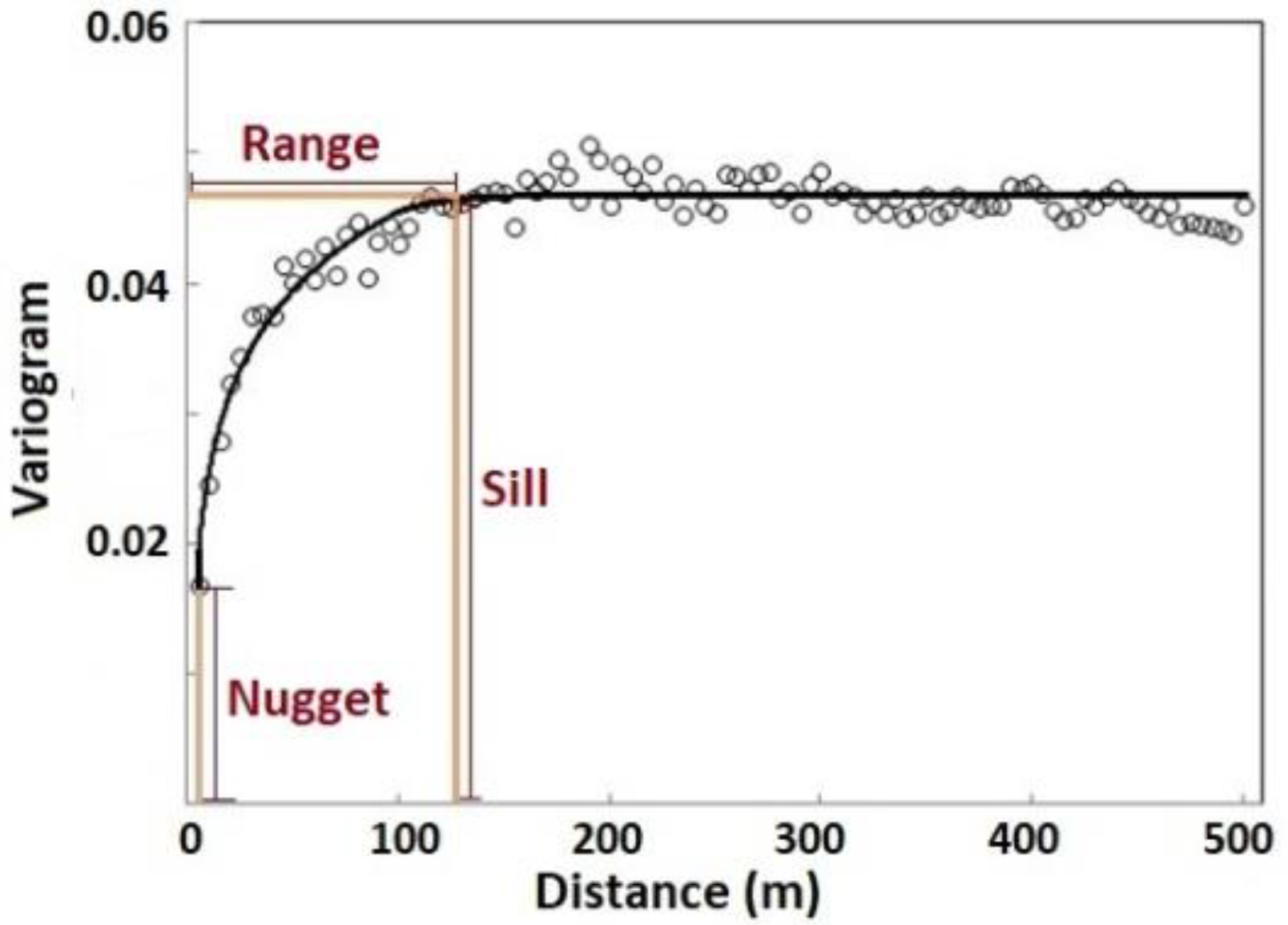
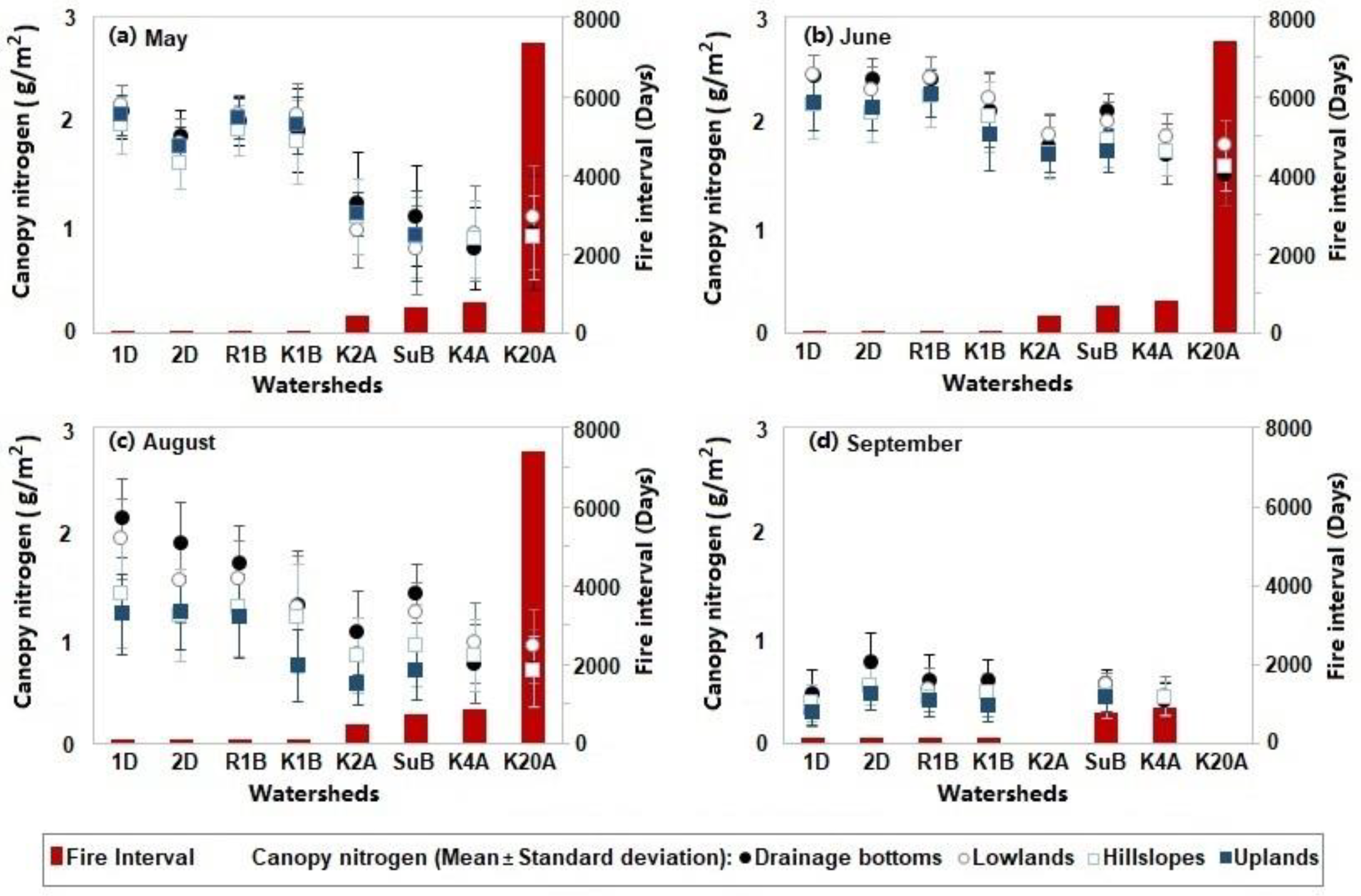
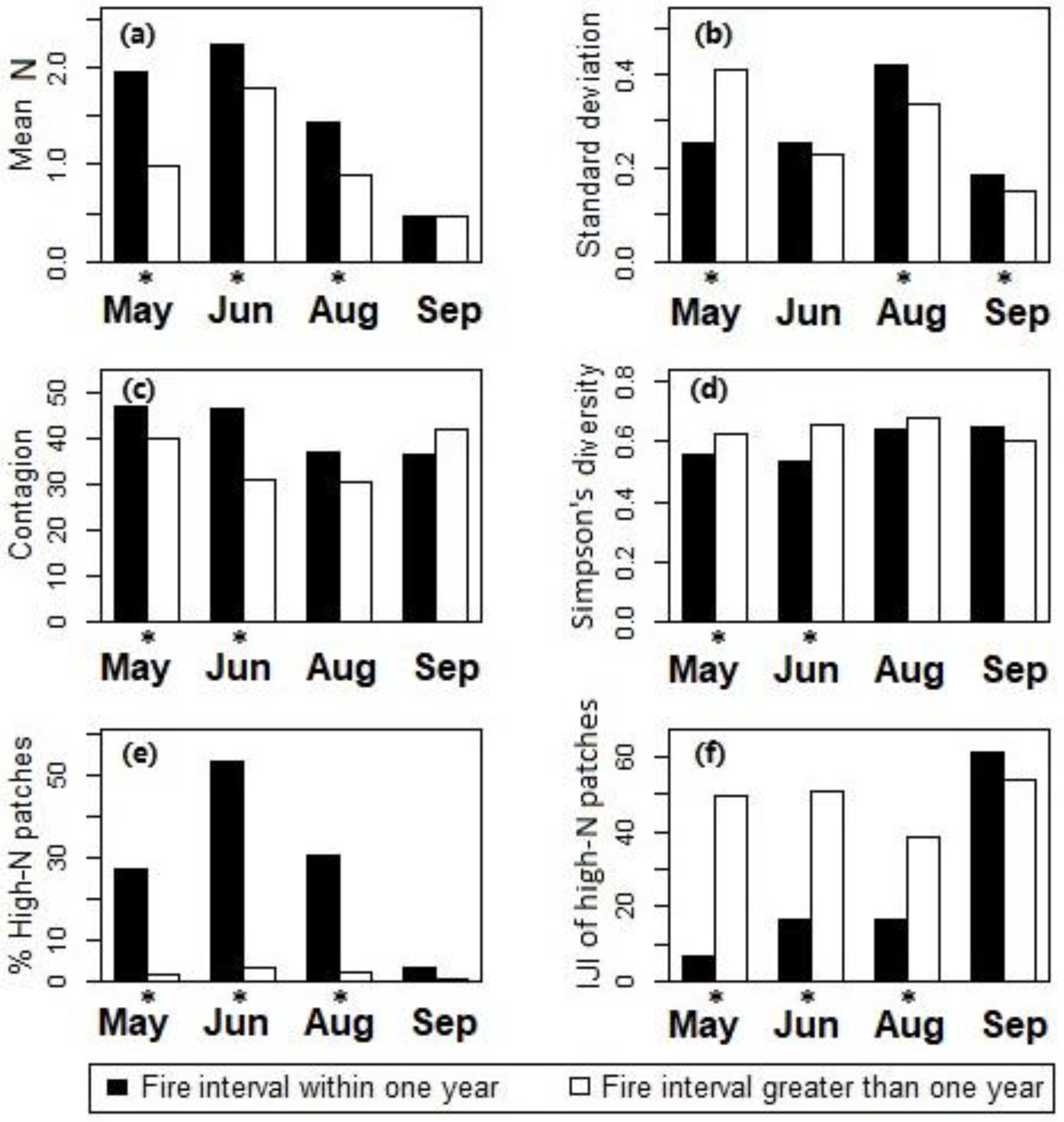
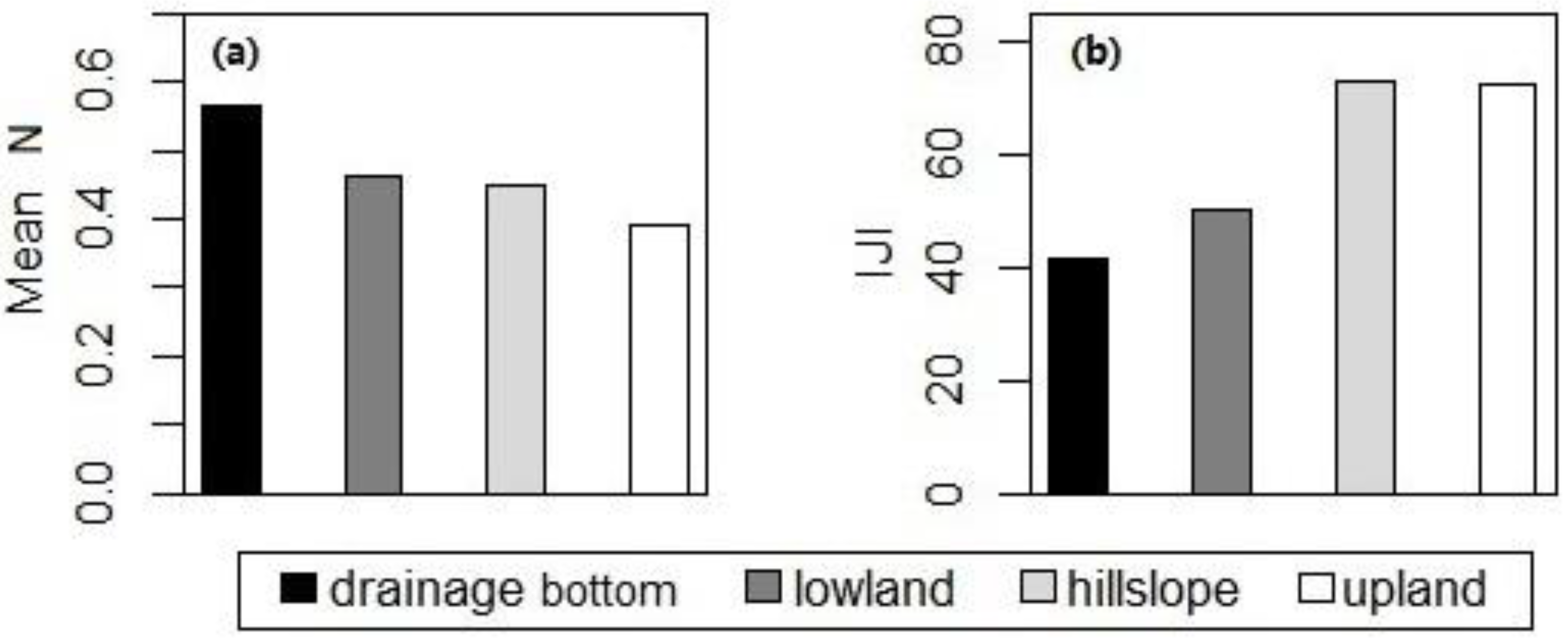
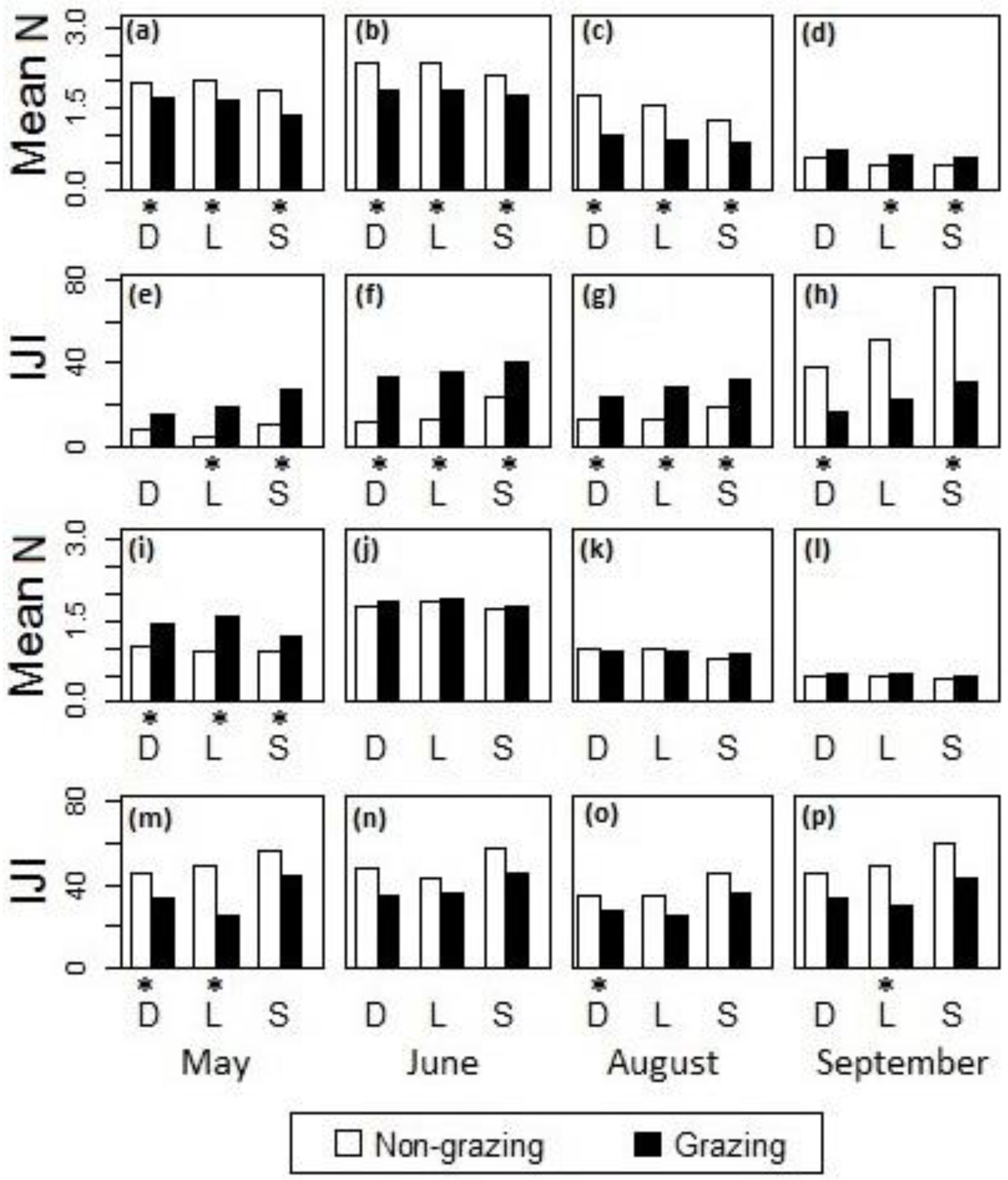
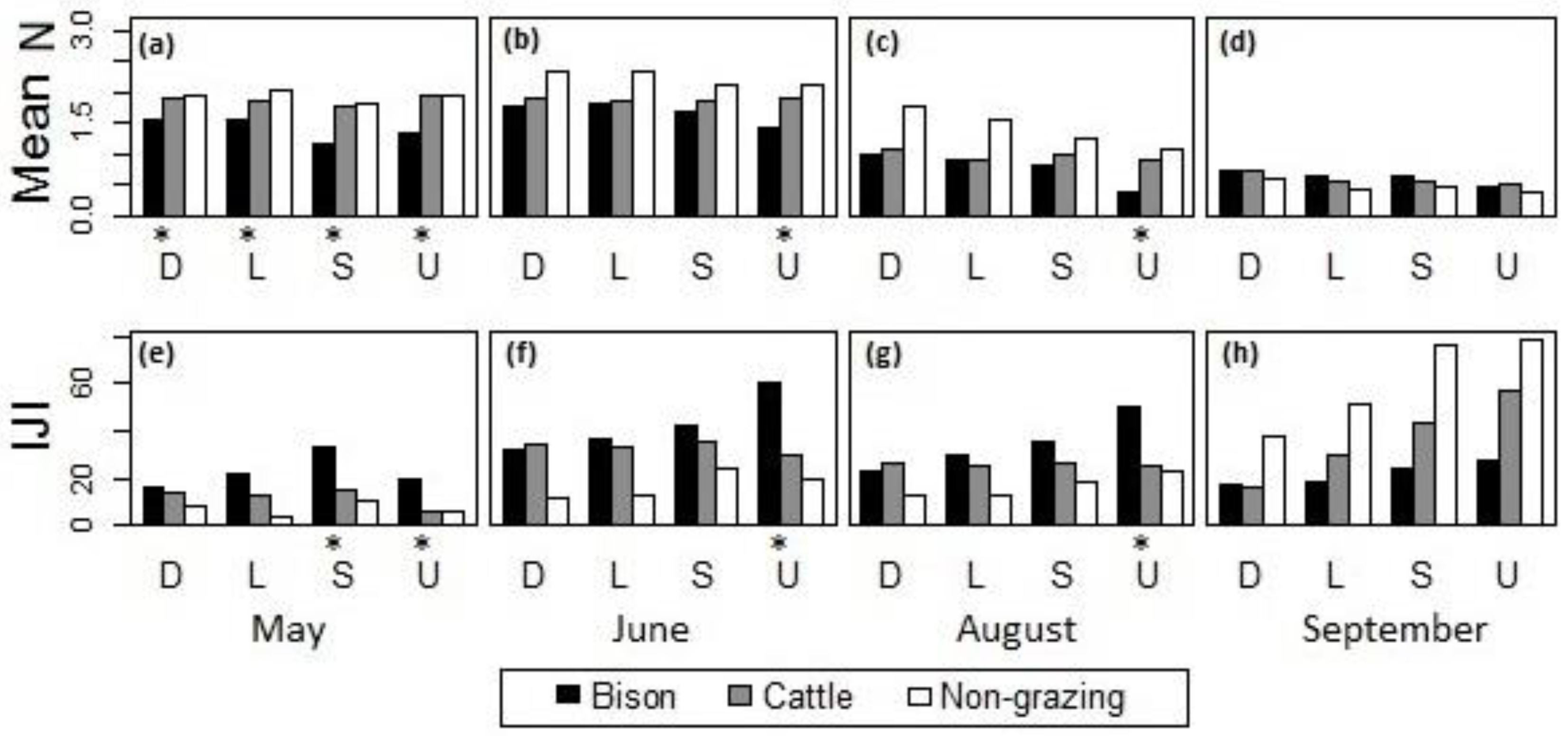
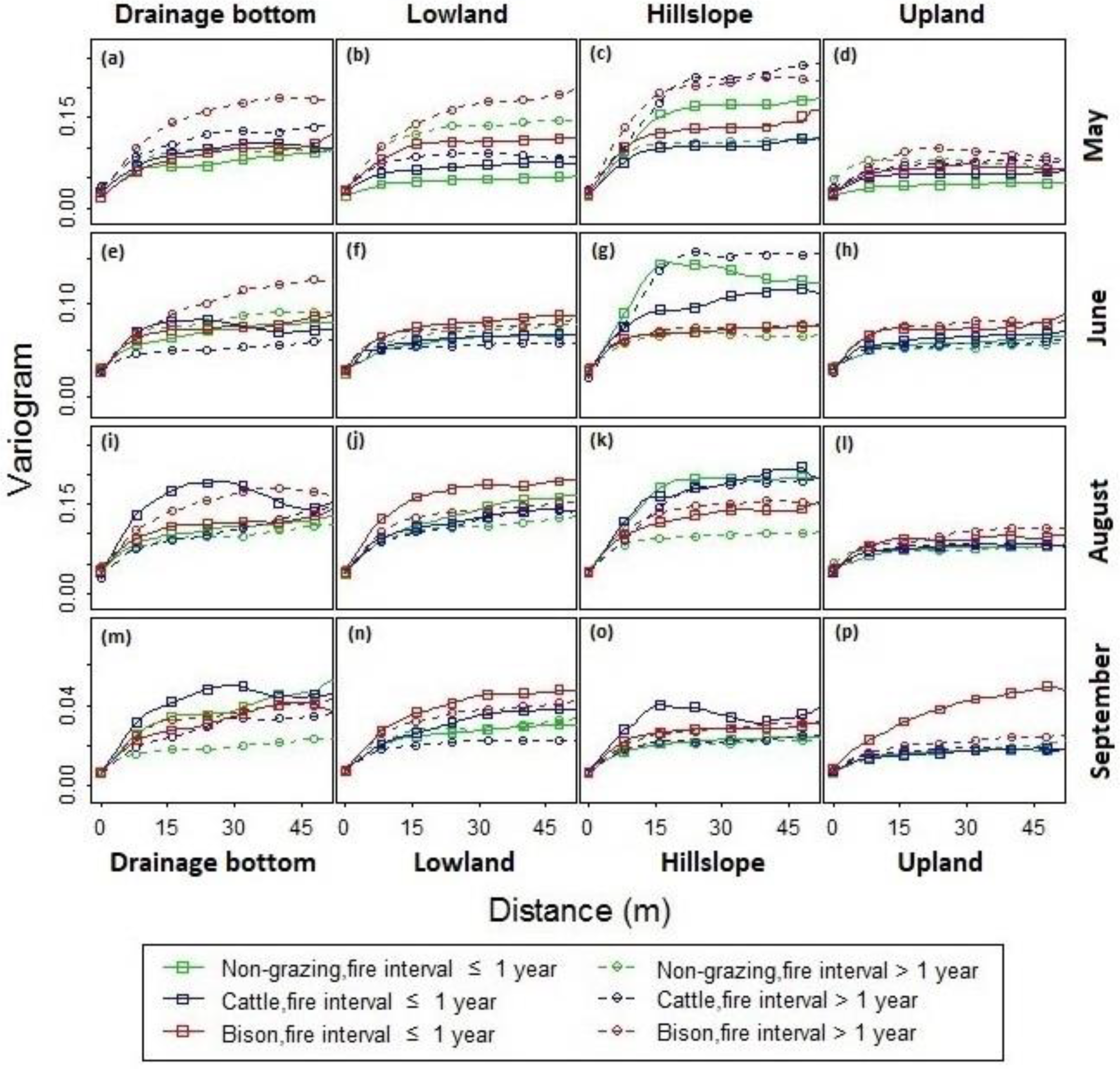
| FRAGSTATS Metric | Range | Description |
|---|---|---|
| contagion index | (0,100] | A measurement of aggregation; the value approaches 0 as the path types become more disaggregated and interspersed; a value of 100 indicates all patch types are maximally aggregated. |
| Simpson’s diversity index | [0,1) | A measurement of diversity; a value of 0 indicates no diversity; as the patch richness increases and the proportional distribution of area among patch types becomes more equitable, the value approaches 1. |
| interspersion/juxtaposition index (IJI) | (0,100] | A measurement of patch interspersion and juxtaposition; the value approaches 0 as the distribution of patch adjacencies becomes increasingly uneven; a value of 100 indicates all patch types are equally adjacent to all other patch types. |
| Canopy Nitrogen Properties | May | June | August | September |
|---|---|---|---|---|
| Mean | 0.9131 | 0.5701 | 0.8969 | 1.0099 |
| Standard deviation | 2.0911 | 1.6487 | 1.2974 | 3.0364 |
| Contagion | 1.2928 | 3.6203 †,* | - | 1.0384 |
| Simpson’s diversity | 1.4088 | 3.3470 | 2.5088 | 1.8052 |
| % High-nitrogen patches | 0.9942 | 0.5250 † | 0.6404 † | 1.0991 |
| IJI of high-nitrogen patches | 1.7855 | 0.2572 | 0.5801 | 0.5700 |
| Mean | Standard Deviation | Contagion | Simpson’s Diversity | % High-N | IJI of High-N | |
|---|---|---|---|---|---|---|
| May | ||||||
| Drainage bottom | 12.08 ** | 2.66 | 0.26 | 0.94 | 3.79 | 6.84 * |
| Lowland | 31.68 *** | 5.85 * | 0.51 | 0.56 | 10.13 ** | 37.69 *** |
| Hillslope | 13.14 ** | 0.05 | 1.61 | 0.93 | 5.67 * | 10.58 ** |
| June | ||||||
| Drainage bottom | 15.55 ** | 0.89 | 14.01 ** | 10.59 ** | 41.66 *** | 26.49 *** |
| Lowland | 32.23 *** | 1.22 | 29.01 †,** | - | 65.16 *** | 17.63 *** |
| Hillslope | 29.24 *** | 0.78 | 2.05 | 0.42 | 13.77 †,** | 19.59 *** |
| August | ||||||
| Drainage bottom | 9.98 ** | 0.66 | 0.03 | - | 3.11 | 28.15 *** |
| Lowland | 15.09 ** | 0.06 | 2.66 | 1.25 | 15.82 *** | 20.50 *** |
| Hillslope | 16.82 *** | 4.94 * | 2.60 | 2.62 | 10.65 ** | 13.70 ** |
| September | ||||||
| Drainage bottom | 0.49 | 0.95 † | 14.06 ** | 7.03 * | 1.85 | 0.83 † |
| Lowland | 2.28 | 0.26 | 0.00 | - | 1.43 | 0.40 |
| Hillslope | 1.19 | 5.93 †,* | 2.25 | 7.24 * | 1.78 | 1.75 |
| Topography | Treatment | Model | Nugget | Sill | Range | Proportion |
|---|---|---|---|---|---|---|
| May | ||||||
| Lowland | Non-grazing | 0.019 | 0.047 | 18 | 0.591 | |
| Cattle | 0.028 | 0.071 | 20 | 0.609 | ||
| Bison | 0.031 | 0.110 | 21 | 0.720 | ||
| Upland | Non-grazing | 0.020 | 0.039 | 16 | 0.472 | |
| Cattle | 0.024 | 0.058 | 16 | 0.583 | ||
| Bison | 0.026 | 0.064 | 16 | 0.592 | ||
| June | ||||||
| Lowland | Non-grazing | 0.026 | 0.066 | 22 | 0.611 | |
| Cattle | 0.028 | 0.064 | 20 | 0.567 | ||
| Bison | 0.028 | 0.079 | 16 | 0.642 | ||
| Upland | Non-grazing | 0.029 | 0.057 | 15 | 0.495 | |
| Cattle | 0.031 | 0.064 | 14 | 0.510 | ||
| Bison | 0.030 | 0.074 | 14 | 0.594 | ||
| August | ||||||
| Lowland | Non-grazing | 0.033 | 0.157 | 40 | 0.789 | |
| Cattle | 0.035 | 0.139 | 34 | 0.748 | ||
| Bison | 0.036 | 0.182 | 22 | 0.802 | ||
| Upland | Non-grazing | 0.038 | 0.077 | 18 | 0.499 | |
| Cattle | 0.035 | 0.081 | 14 | 0.569 | ||
| Bison | 0.037 | 0.091 | 14 | 0.592 | ||
| September | ||||||
| Lowland | Non-grazing | 0.008 | 0.030 | 22 | 0.733 | |
| Cattle | 0.007 | 0.037 | 32 | 0.802 | ||
| Bison | 0.007 | 0.046 | 28 | 0.841 | ||
| Upland | Non-grazing | 0.007 | 0.018 | 20 | 0.616 | |
| Cattle | 0.007 | 0.018 | 19 | 0.601 | ||
| Bison | 0.009 | 0.050 | 48 | 0.817 |
© 2019 by the authors. Licensee MDPI, Basel, Switzerland. This article is an open access article distributed under the terms and conditions of the Creative Commons Attribution (CC BY) license (http://creativecommons.org/licenses/by/4.0/).
Share and Cite
Ling, B.; Raynor, E.J.; Goodin, D.G.; Joern, A. Effects of Fire and Large Herbivores on Canopy Nitrogen in a Tallgrass Prairie. Remote Sens. 2019, 11, 1364. https://doi.org/10.3390/rs11111364
Ling B, Raynor EJ, Goodin DG, Joern A. Effects of Fire and Large Herbivores on Canopy Nitrogen in a Tallgrass Prairie. Remote Sensing. 2019; 11(11):1364. https://doi.org/10.3390/rs11111364
Chicago/Turabian StyleLing, Bohua, Edward J. Raynor, Douglas G. Goodin, and Anthony Joern. 2019. "Effects of Fire and Large Herbivores on Canopy Nitrogen in a Tallgrass Prairie" Remote Sensing 11, no. 11: 1364. https://doi.org/10.3390/rs11111364




